1 Happinness at work
- 1.1 Find your happiness
- 1.2 Hierarchy of needs
- 1.3 Theory X and theory Y
- 1.4 Promte motivation
- 1.5 Involve staff
1.1 Find your happiness
Happiness, surveys, at work, age

Happiness is looking for it. Jules Renard
Everyone has their own interpretation of happiness. However, some universal characteristics of positive psychology (what is good) are often taken into account:
- positive emotions, satisfaction (pleasant life)
- commitment, values, interests (motivated life)
- serve a common cause (meaningful life)
According to a Johns Hopkins University study of nearly 8,000 students who were asked “what goal do you consider very important now?” the main answers were:
- 78% find purpose and meaning in life
- 16% earn a lot of money
To be happy, is to be happy at home but also at work where we often spend a large part of the day. To achieve a fair balance, one condition is to want and be able to make all stakeholders happy:
- spouse, children and loved ones
- colleagues, customers and competitors
- owners, service providers and media
- society and environment
Desire is the only driving force. Aristotle
Seeking happiness at work is human because it is a deeply intrinsic desire.
According to 2013 Gallup surveys around the world:
- 13% of employees are motivated (really committed)
- 63% are not too motivated (rather passive and indifferent)
- 24% are demotivated (actively disengaged)
For France the figures are 9% motivated, 65% not motivated, 26% demotivated.
So there is work ahead for many people and for a long time.
Happiness causes success and achievement and not the other way around. Shawn Achor
A study of the (intimate) diaries of 180 nuns, born before 1917, from the school of the Sisters of Notre Dame, provides an answer to the chicken and egg paradox.
50 years later the vast majority (90%) of the sisters, who had a diary with more positive (happy) content, were alive at the age of 85. Sisters alive at 85 years old, who had a diary with more neutral or negative content, were 34%.
At 20 years old, the happy sisters could not be happy because they knew they would live a very long time.
Good health and long life is the result of their happiness and not the cause.
Many studies show that a happy person at work:
- is more efficient (30% more)
- makes its customers happier (and shareholders as well)
- is in better physical and mental shape (two times less sick)
- is passionate about work (six times less absent)
- is more creative (55% more)
- has the will and power to better solve problems
- is more innovative
- contributes to a better climate (more effort for the team)
- is a better parent
- is better in bed
Being happy in your job means choosing a job that you would like to do even if you are not paid (or poorly paid). This also involves leaving your comfort zone and fighting your natural temptation to resist change (see § 6.3).
Happiness creates performance
The success of the best workplaces is often attributed to corporate culture and high staff engagement.
Finding happiness at work means:
- share the company’s vision
- adhere to the values
- be respected and respect others
- benefit from:
- involved, exemplary, horizontal leadership
- warm relationships between colleagues
- be able to afford to:
- have:
- freedom
- autonomy
- information
- take direct responsibilities in relation to:
- oneself
- others
- society
- resolve problems as a team
- develop your knowledge and skills
- express one’s talents
- have:
- love your work (being able to thrive):
- live your passion
- have self-confidence
- be proud of the results
- be aware that one's contribution is:
- necessary
- recognized
- appreciated
- welcome
The 2012 StepStone European survey shows that the factors that most influence happiness at work are primarily:
- respect for staff
- interesting work
- good atmosphere
- fair environment
- recognition of work
- possibility of being yourself
- work-private life balance
- good relationships with colleagues
- means to do your job correctly
- decent salary (tenth place!)
According to Gallup surveys in the United States (and other “developed” countries), the percentage of very happy people has barely changed over the last 50 years. While real income per capita has more than doubled, the comfort of life has improved enormously (more material goods, more health, more years of life).
Paradox which could possibly be explained in societies that have become richer by the increase in depression, alcoholism, drugs, crime and the fact that we compare ourselves with our close colleagues and neighbors and not with groups poorer or unhappy.
Certain behaviors can be explained by the feeling of happiness in relation to age (Eurobarometer surveys 1975-2000) shown in figure 1-1.
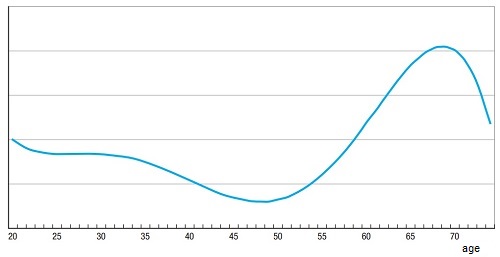
Figure 1-1. Happiness and age
The seven major factors promoting happiness are according to Richard Layard:
- family relationships
- the financial situation
- work
- community and friends
- health
- personal freedom
- personal values
1.2 Hierarchy of needs
Maslow, pyramid, needs

Happiness is not in having but in being
The hierarchy of needs published by Abraham Maslow in 1943 is now often represented in the form of a pyramid like the one shown in Figure 1-2.
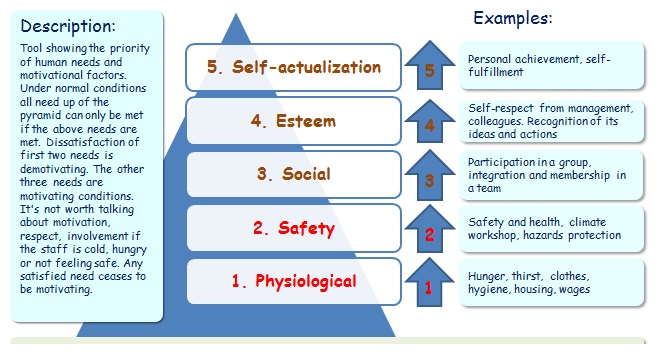
Figure 1-2. Maslow’s pyramid
Maslow's pyramid shows the priority of human needs and motivators. Under normal conditions, motivation follows a hierarchy of needs: physiological need, need for safety, need for social belonging, need for esteem and need for self-actualization.
Salary is not a motivating factor; it is a physiological need satisfaction factor. But when there is inequality, it can become very demotivating.
The company cannot do much to stimulate happiness and creativity, but it can do much to kill them. Scott Adams
The higher we go to the top of the pyramid, there are more:
- respect
- trust
- mutual aid and
- freedom
- the more the person is:
- committed
- motivated and
- passionate
- the more participation and contribution to activities of:
- improvement
- innovation and
- creation
The need for esteem is a motivating factor. These are the conditions for wanting to succeed in your personal achievement. Some examples of efforts in this direction:
- pleasant working environment
- nursery
- room for:
- sports
- relaxation
- collective games:
- billiards
- baby foot
- ping-pong
The need for achievement is the highest motivator. To thrive, everyone must have real freedom (of course “The freedom of some stops where that of others begins”), to be able to live their passion, to find their happiness at work.
To simplify, inspired by Chip Conley's pyramids, we can use a pyramid with three levels like the one shown in Figure 1-3.
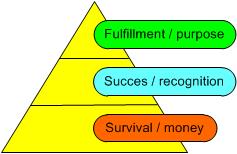
Figure 1-3. Simplified pyramid of links and motivations
To find out what passion you may have, you need to ask yourself questions like:
- if you have no worries about money, what would you do with your time?
- what work would you do?
- what cause would you get involved with?
1.3 Theory X and theory Y
McGregor, theory X and theory Y

Happiness is the only wealth that doubles if you share it. Albert Schweitzer
Douglas McGregor in his book The Human Side of Enterprise published in 1960 divides the image we have of people into two categories (Theory X and Theory Y).
The first (classic) image is theory X. The average human being:
- has an inherent aversion to work and avoids it if he can
- provides the expected effort only under pressure or for money
- prefers to be directed (what to do and how to do it) and avoids responsibilities
- is only motivated if he fears for his safety
- lacks creativity (except to avoid the regulations)
- gives nothing more than what is asked of him
The second image McGregor encourages is Theory Y:
- physical and mental effort is as natural as playing or relaxing
- the average human being wants to achieve the objectives to which he has committed himself
- commitment to achieving goals is linked to self-fulfillment
- he seeks and accepts responsibilities (under certain conditions)
- imagination, ingenuity and creativity are widely present in people
- he cares about giving the best of himself
To apply theory Y, top management must:
- help people in their desire to realize their potential
- ensure that the objectives of people and the company are consistent
- create conditions in which people can influence decisions that concern them
- encourage participation so that people accept more responsibility
In the case of theory Y, top management is not concerned with motivating people but with trusting them by giving them:
- more responsibilities
- the opportunity to unleash their creativity
- the opportunity to participate in the negotiation of objectives
- the possibility of:
- solve certain problems themselves
- take initiatives to improve working conditions
- focus on the added value brought to the customer
- contact customers directly
- work directly with suppliers
Top management gradually pushes staff in the direction of Theory Y by knowing how to prepare the ground and gain the trust of all staff. The goal is to make everyone want to get involved in rewarding and enriching work.
The management of an American company asked itself the question of how to build trust among staff.
A question was sent to all staff. Which category (A or B) do you think you fall into?
A. I feel adult and responsible, I want to contribute and do a good job, I care about the success of the company, I come to work every day with enthusiasm, I can be trusted.
B. I feel safe when I am managed, I work to earn my bread, this company or another it's the same, I'm here for the moment, I don't know if I can be trusted.
The result was 95% A and 5% B.
As a result, management and management simplified many procedures taking into account the trustworthy majority. The impact was largely beneficial.
1.4 Promote motivation
Motivation, behavior, survival

There is only one person to motivate us: ourselves! Laurence Vanhée
In 1993 Microsoft launched the Encarta universal encyclopedia project, with the contribution of hundreds of personalities from around the world. The encyclopedia was sold on CD and DVD then on the Internet from 2000 and was available in 8 languages. Encarta was shut down in 2009 because visits to online encyclopedias in the United States were only 1.27% compared to 97% for Wikipedia.
Wikipedia is a general and multilingual encyclopedia created in 2001 under the GNU General Public License. It allows everyone to write and modify articles, hence its definition as a participatory encyclopedia or free work of massive non-profit collaboration. Wikipedia has become the most visited online encyclopedia in the world with more than 58 million articles in more than 300 languages.
For any project the contribution of millions of volunteers is an unbeatable force.
Motivation explains why behavior occurs (see figure 1-4) and includes:
- the survival instinct (hunger, thirst, reproduction)
- the agreement to obey work organization in society (extrinsic motivation):
- seek rewards (encouragement)
- avoid punishment (discouragement)
- increase profits (wealth, safety, place in society)
- capacity for interest, involvement (intrinsic motivation):
- autonomy
- curiosity
- desire to learn
- creation
- fun
- enthusiasm
- experimentation
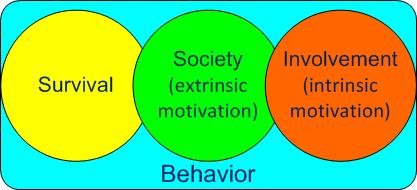
Figure 1-4. The behavior
Money (salary, carrot) is often a powerful motivator, especially for routine work. But numerous studies have shown that for complex and especially intellectual work, money is not at all motivating. When you have to show creativity, imagination, innovation, money is often even demotivating.
Tests carried out by numerous scientists show that the mind inhabited by remuneration disturbs creative activities and contradicts the intrinsic need for freedom to choose what one wants to do.
Intrinsic motivation (see figure 1-5) according to Daniel Pink (see his book Drive, The Surprising Truth About What Motivates Us) is based on three pillars:
- autonomy in activity (desire to direct our own life, to make choices, to be accountable):
- what we do
- when we do it
- how we do it
- who we do it with
- mastery of the activity (desire to always do better):
- develop our capabilities
- balanced tasks (neither too easy nor too difficult)
- have fun (transform part of the work into play)
- identification with the purpose:
- give meaning to our life
- work with others for a goal greater than ourselves (making the world a better place)
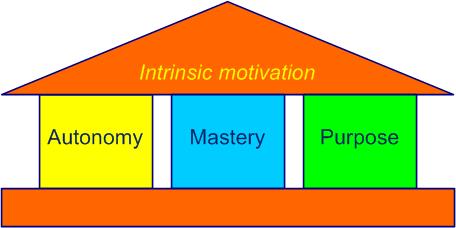
Figure 1-5. Intrinsic motivation
It is commitment that drives performance and not the other way around
Some conditions to promote motivation (encourage staff to work with desire and pleasure):
- equity:
- respect
- goodwill
- confidence
- self-development:
- important objective and in line with the values and vision of the company
- freedom to act (little or no control)
- voluntarily commitment
- challenge to overcome
- urgency of the task
- exercise your knowledge
- learn more
- team autonomy
- salary:
- fair
- sufficient
- equal or superior to that of competitors
- pleasant places
- experience satisfaction
- be able to admire the results
- surprising rewards (especially non-material) to celebrate progress
In the 2000s, researchers at Cornell University selected 320 small businesses.
The first half of the companies (A) had traditional management. In the second half of the companies (B) the employees were completely autonomous.
The analysis showed that the growth rate of companies B was 4 times higher than that of companies A and they had staff turnover 3 times lower.
1.5 Involve staff
Happy company, conditions, pitfalls
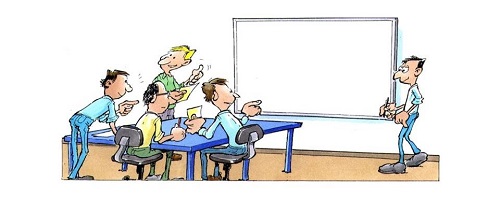
A satisfied need is not a motivator of behavior! Douglas McGregor
Always consider staff as adults and responsible people, capable of making the necessary decisions. In addition, collective intelligence makes it possible to obtain exceptional performance.
Motivation is positive and contagious when work is perceived as a need for accomplishment, achievement, self-fulfillment (top of Maslow's pyramid).
Secrecy around pay is an example of a possible source of low morale, poor performance, and high staff turnover.
To give their best every day, staff must feel like they are:
- listened to
- heard
- understood
- taken into account
- informed
- encouraged
- helped
- supported
In this way the personnel:
- does his best
- increases their skills and know-how
- is worthy of the trust granted
- knows he is being treated fairly
- feels like a full member of a close-knit team and a sustainable company
- better understands the meaning of his work
- is proud of his work
No performance without happiness. Jean-François Zobrist
Figure 1-6 shows how we can progress towards a happy company by creating more happiness for employees and more performance for the company.
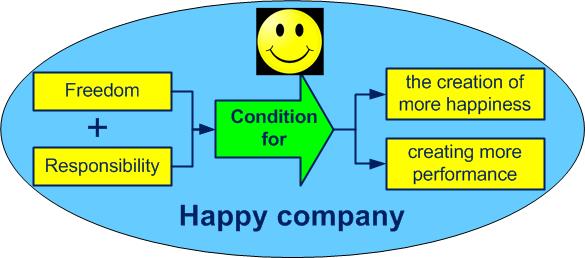
Figure 1-6. The happy company
Some conditions to thrive at work:
- participate in:
- developing the vision
- preparation and decision-making
- improvement of working conditions
- distribution of profits
- respect common values
- set the right goals yourself
- benefit from a climate of cooperation in the team and among the departments
- include a playful side in the activities
- assume your mission and responsibilities in the team
- know that the hierarchy is regularly interested in the skills and commitment of each person
- solve problems
- gain and maintain independence
- have an optimized, secure and pleasant working environment
- change activities often (repetitive tasks are guaranteed to cause boredom)
- take on exciting challenges
- communicate in both directions (encourage feedback)
- follow captivating training courses
- have direct links and love your customer
- share good practices
- receive deserved recognition
- be encouraged in innovation
- link rewards to team performance
 Pitfalls to avoid:
Pitfalls to avoid:
- low top management commitment
- lack of confidence
- poor communication of vision and objectives
- poorly defined missions and responsibilities
- lack of recognition of the efforts made
- use Taylor’s scientific organization of work (separate those who design from those who produce)
- tolerate responses like:
- it's not my job
- I don't have time
- we have always done it like this
- this change is happening too quickly
- it’s too risky
- it will never work for us
- unsuitable documentary system and procedures:
- with unnecessary activities
- written without the participation of those who must apply them
- written primarily for the external auditor
Self-assessment or that carried out between team members is a way to help us:
- see where we are
- confirm commitments
- look at the future calmly
Some tracks:
- evaluate the achievement of objectives and if necessary set new objectives
- ask everyone to evaluate their own performance
- establish our strengths and weaknesses
- look for opportunities for improvement and progression
- find and overcome obstacles to:
- creativity
- curiosity
- initiative (being allowed to make mistakes)
- innovation
- define how to improve the skill level (new training)
- identify personal contribution to team indicators
- determine what is really enjoyable at work
- compare yourself to the best
- check if it is possible to take more initiatives and responsibilities
The Manhattan military project (the creation of the atomic bomb) was moving too slowly. Secrecy was the rule for security reasons and the nature of the project was hidden from all staff.
To move up a gear, the head project leader, Robert Oppenheimer, decided to inform all team members of the nature of the project, its extreme urgency and its critical importance to the end of the war. Unsuspected energy freed itself and work advanced in leaps and bounds.
Informing staff about the mission, giving meaning to their work and trusting them is a guarantee of success for any project.
